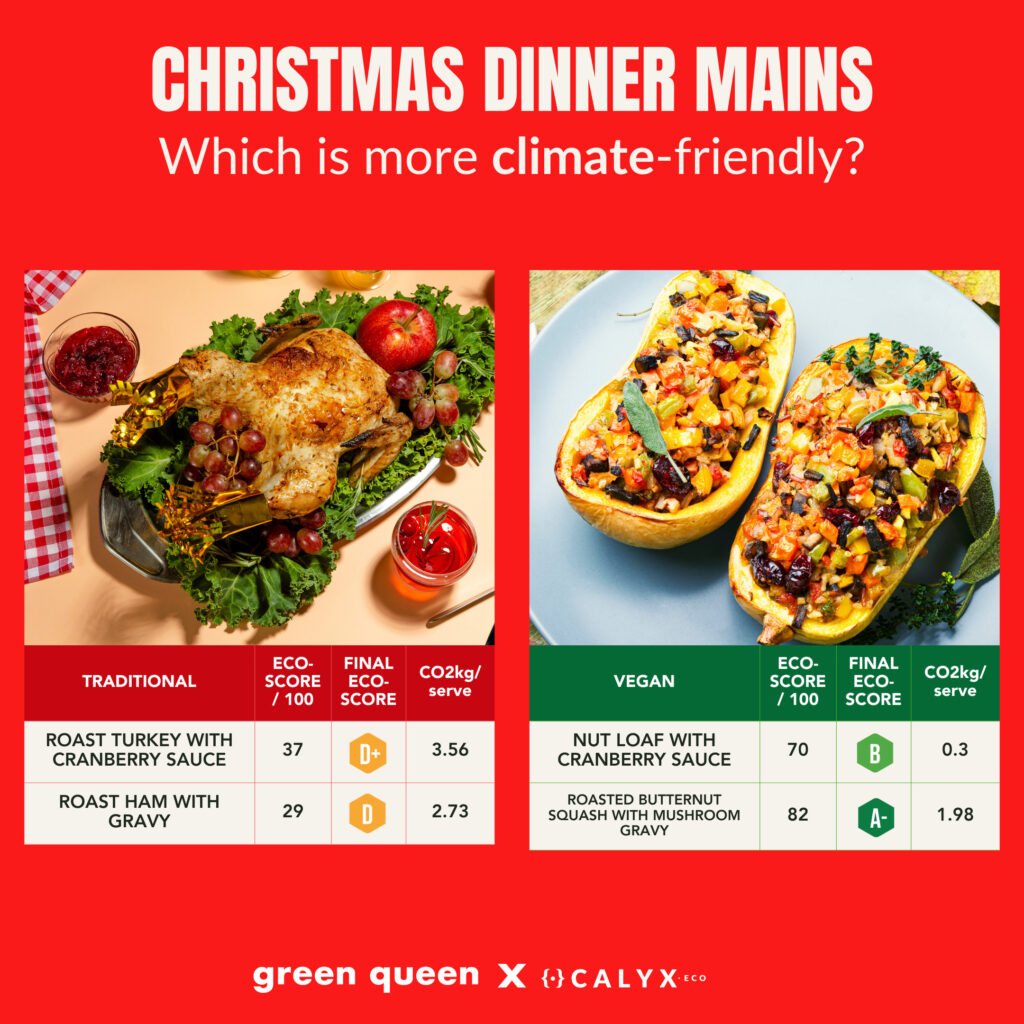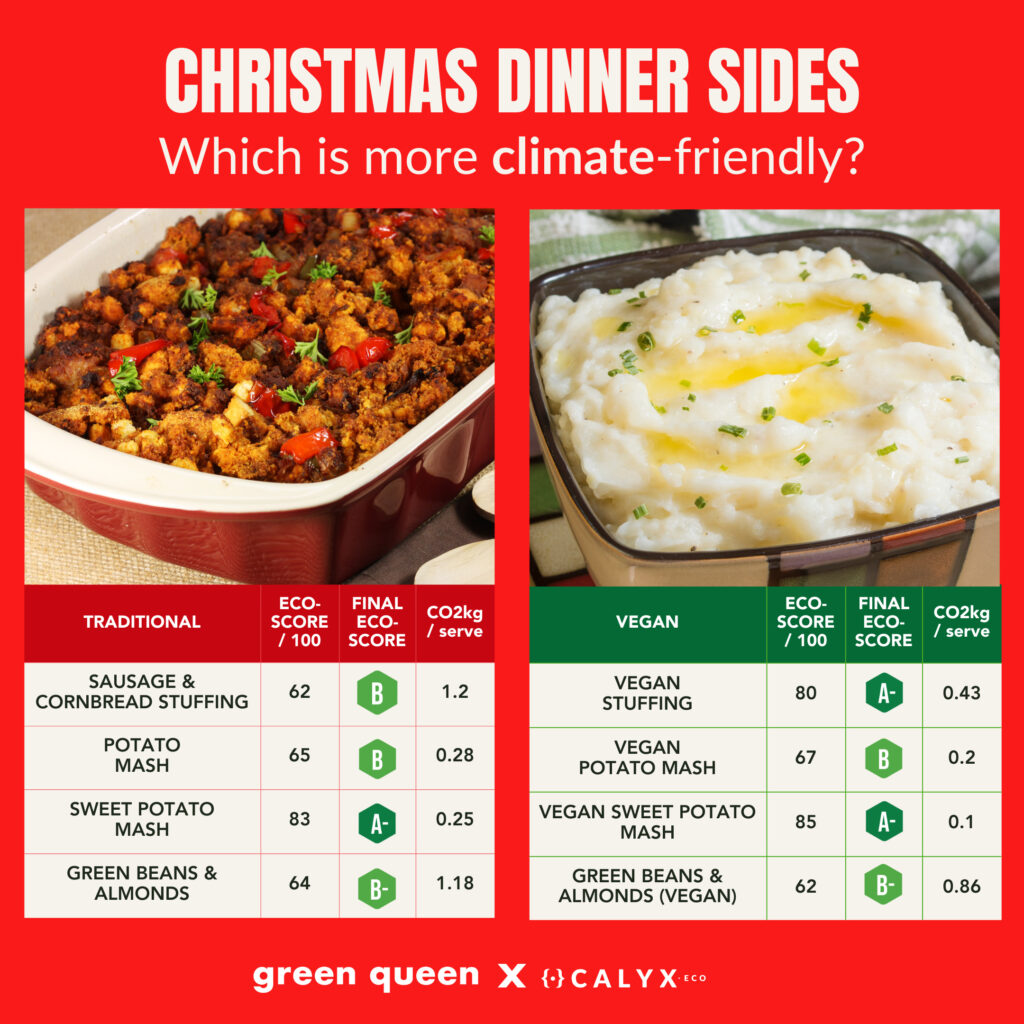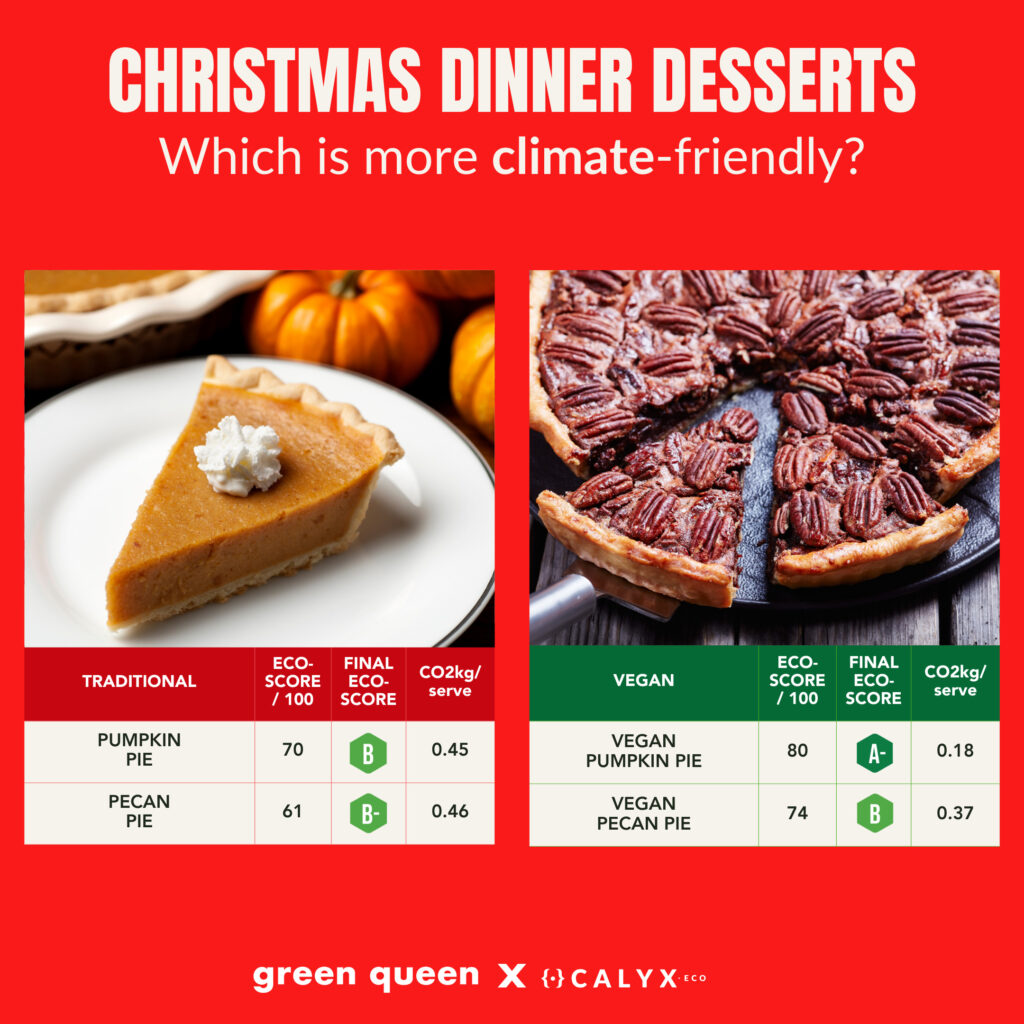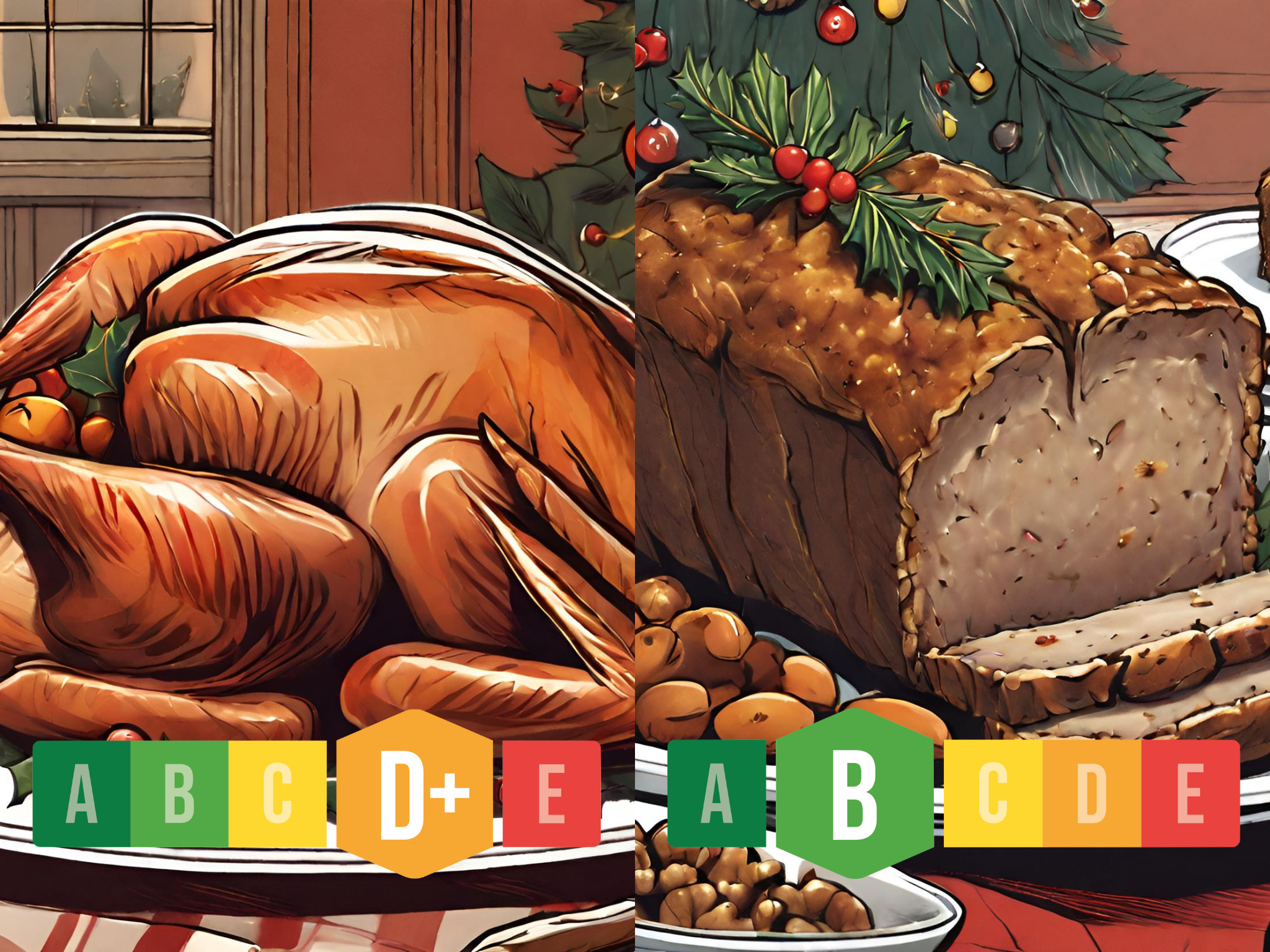Turkey vs Nut Roast: We Calculate The Climate Impact of Your Christmas Dinner
7 Mins Read
Nut Roast or Turkey with Trimmings? Which is better for the planet? To find out, Green Queen asked climate data intel startup Calyx to calculate the carbon footprint and Eco-Score of a traditional Christmas meal versus a vegan feast and here’s what we found.
Can you hear the sleigh bells? Christmas is almost here! And without sounding too Scroogey, that means waste and excess everywhere. Particularly on the big family meal table…but what does the data say? We wanted to know how a vegan Christmas dinner compared with a traditional turkey and ham extravaganza
To give you a fuller view, Green Queen has teamed up with Calyx, an Australian data intelligence company that provides sustainability insights for the food and beverage sector. It specialises in carbon, water and biodiversity measurements for companies’ products and ingredients, with its experts having over 27 years of experience in the agrifood sustainability space.
Calyx has worked with the likes of Chipotle, Walmart, Nestlé, the World Economic Forum, the Australian Open and the Olympics. As we approach Christmas – which happens to be the same month leaders from around the world just convened in Dubai for COP28 – food is firmly in focus this year.
And rightly so: the food system accounts for over a third of all emissions and is the greatest driver of deforestation. Christmas, meanwhile, is a period responsible for a huge climate footprint. Research has found that three days of festivities can result in as much as 650kg of carbon emissions per person –that’s 5.5% of our entire year’s share, or, as the researchers put it, over 1,000 Christmas puddings.

What is an Eco-Score?
To bring about change, we can start with our plates. The Eco-Score provides a scientifically robust methodology and simple communication strategy for footprinting food menus, based on a farm-to-fork life-cycle analysis (LCA). Additionally, it integrates parameters not always well-measured in an LCA: Calyx’s Eco-Score takes into account a product’s carbon footprint, water use and pollution, land use, packaging, as well as its impact on biodiversity and animal welfare.
What do consumers think about eco-scores?
Eco-scores are already used by many companies across multiple countries, and they have been shown to influence consumers’ purchasing habits. A small 255-person study in the UK revealed that 63% of consumers would be deterred from buying meat if it had a negative climate score, and 52% would consider buying a plant-based alternative if it fared better. Meanwhile, 58% said they’re interested in eco-labels but require more information.
On a larger scale, an analysis of three global YouGov polls totalling 10,540 participants found that two-thirds of respondents find carbon labelling a good idea across all countries surveyed.
About the menus and the recipes
To measure the impact of a Christmas dinner, we sourced recipes from popular cooking websites. A majority were from NYT Cooking, while others were from online blogs Once Upon a Chef, Easy Peasy Foodie, Best Recipes and Veggie Desserts.
The two menus had eight dishes each, with a mix of mains, sides and desserts, and the Eco-Scores ranged from A+ (best) to E- (worst). Here’s what Calyx’s analysis found.
The mains: turkey and ham vs nut loaf and stuffed squash

For the mains, the traditional Christmas menu contains roast turkey with cranberry sauce and roast ham with gravy. The turkey has a carbon footprint of 3.56kg per serving, with an Eco-Score of 37 (out of 100), or D+.
The ham, meanwhile, had the lowest score across both menus. While its carbon footprint was lower than the turkey dish, at 2.73 kg per serving, when accounting for other factors (like land and water use, animal welfare, biodiversity, etc.), its impact is much worse. It scores a D on the rating scale, earning just 29 out of 100.
In comparison, the vegan mains have a much lighter effect on the environment. A nut loaf with cranberry sauce only produces 0.3kg of CO2 per serving, with a score of 70 and a B rating. In terms of pure carbon footprint, this is 11 times lower than the turkey and nine times lower than the ham.
And a stuffed butternut squash dish with mushroom gravy scores seven better. It has a higher carbon footprint per serve (1.98kg), but the overall eco score is 82, or A-. This is the joint-highest rating across both menus.
The sides: stuffing, mash and green beans

We chose four sides across both menus: two mashes, one green, and one stuffing each. Starting with the latter, a sausage and cornbread stuffing has a footprint of 1.2kg per serving, with an Eco-Score of 62 and rating of B-. On the other hand, a plant-based stuffing made from a base of baguettes, pecans, onions, celery and vegan butter has an Eco-Score of 80 out of 100, or A-, accounting for 0.43kg of CO2 per serving – almost three times lower than the meat-based stuffing.
The two mashed dishes – made from potatoes and sweet potatoes – have the lowest carbon footprints. A vegetarian potato mash (with milk and butter) produces 0.28kg of carbon per serving, but the heavy use of dairy brings its Eco-Score down to 65, or B. Similarly, the vegan mash has a CO2 footprint of 0.2kg per serving, but the use of soy milk and vegan butter means its Eco-Score is only slightly higher, at 67 or B.
Mashed sweet potatoes make for the most sustainable dish on the Christmas dinner menu – vegan or otherwise. The traditional cream- and butter-based version emits 0.25kg of carbon per serving, with a high score of 83 or A-. A vegan alternative with soy milk and plant-based butter brings this up to 85 (still A-), with only 0.1kg of carbon emissions.
Finally, a simple green bean dish with almonds has a lower Eco-Score than the mash. If cooked in butter, it’s rated as B- with 64 out of 100. If prepared in coconut oil, it’s still B-, but with 62 out of 100 on the green rating. This is despite the latter having a lower carbon footprint – it’s key to remember that carbon emissions are just one aspect of the Eco-Score, and taking into account other factors like biodiversity and animal welfare, using coconut oil maker for a marginally lower overall score.
The desserts: traditional vs vegan pumpkin and pecan pie showdown

On to the sweet stuff. We chose two pies – pumpkin and pecan – comparing traditional recipes with vegan alternatives (all with store-bought pie crusts). The dairy- and egg-based pumpkin pie produced 0.45kg of CO2, with a 70 or B- Eco-Score. The vegan version – containing coconut oil, maple syrup and cornstarch – ranked higher (80 or A-) with a 2.5-times lower carbon footprint (0.18kg).
Meanwhile, a pecan pie with butter, honey, eggs, whipped cream/ice cream, and golden syrup was responsible for 0.46kg of carbon emissions per serving, with an Eco-Score of 61 out of 100, or B-. A vegan version – with maple syrup, brown sugar, coconut oil and silken tofu – ranked higher here too, with 0.37 of carbon emitted, and a total score of 74 or B.
Result: a vegan Christmas dinner is better for the planet
Overall, the vegan Christmas dinner trumps a traditional one heavy on meat and dairy. While the latter accounts for 10.12 of CO2 emissions per serving, the plant-based one has less than half the impact at 4.43kg. This chimes with research showing that animal-derived foods have twice as high greenhouse gas emissions as plant-based ones.
Calyx’s overall Eco-Score for a Christmas dinner with conventional dishes is 53 out of 100, which translates to a C rating – in contrast, the vegan menu ranks 76 out of 100, a B rating.
“To save the planet, we all need to do better,” said Calyx co-founder and CEO Lauren Branson. “Impact transparency is the first step to understanding the impact our food has on the planet, and the Calyx Eco-Score – developed in partnership with Beelong – is a great starting point. We know that once people can see the impact their food choices have on the planet, they make better decisions. What will you be dishing up this Christmas?”
Santa may wear red – but can we make our Christmas green?




